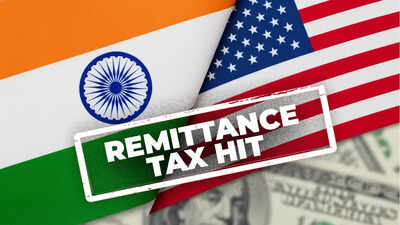Remittances tax: How Donald Trump’s ‘The One Big Beautiful Bill’ may turn out to be ugly for Indians in the US – Times of India

US President Donald Trump’s ‘The One Big Beautiful Bill’ may actually turn out to be ugly for Indians living in the US. By 2026, Indians sending money from the US back home may have to pay a 3.5% remittance tax. ‘The One Big Beautiful Bill’ carries significant implications for many Indian residents in the United States, including H-1B visa holders and permanent residents. International money transfers from the United States to India might become more expensive by 2026 if President Donald Trump’s proposed legislation receives approval. The extensive 1,116-page ‘One Big Beautiful Bill’, which includes tax modifications and expenditure reductions, has received House approval and awaits Senate consideration. The final vote is anticipated in late June or July, with implementation contingent upon passage. The House passed the bill on May 22, reducing the initially proposed remittance tax rate of 5%.The legislation stipulates that only non-US citizens, including permanent residents and employment visa holders, would be subject to this tax. US citizens who incur the 3.5% tax can claim a credit during their tax filing, provided they use verified remittance providers.For Indian nationals, this holds particular importance as they constitute one of the largest immigrant populations in the United States. India Gets Largest Chunk of Remittances From USAccording to the Migration Policy Institute Data, over 2.9 million Indian immigrants resided in the United States in 2023. The US is Indians’ second most preferred global destination after the United Arab Emirates. Statistics also indicate that Indians represent the second-largest foreign-born population in the United States, following Mexicans, comprising 6% of the total 47.8 million foreign-born residents in 2023.The US continues to be the largest source of global remittances. RBI’s remittance survey released in March indicates that of the total $118.7 billion remittances in 2023-24, the United States contributed approximately $32 billion, which is approximately 28 per cent.How Indians in US will be hitShould this legislation take effect, and even if one were to maintain current remittance levels, the Indian community would face an additional tax burden of $1.12 billion!Even students earning income through various work opportunities would need to pay the 3.5% tax if they wish to transfer their earnings to India upon completing their studies and returning.Also Read | Big export boom: India benefits from Donald Trump’s tariffs; Indian firms see competitive position in the US tariff scenarioSince there is no minimum amount specified, the taxation applies to remittances of every value. The rule would impact all categories of Indians residing in the US, including those on H-1B visas, L-1 visas (for intra-company transfers), and permanent residents. Any money sent to relatives in India or invested in Indian assets, such as securities or real estate, would be subject to a 5 per cent deduction by the remittance service provider (like a US bank).This regulation is likely to affect individuals who transfer money on a regular basis.Amarpal Chadha, Tax Partner and Mobility Leader at EY India explains, “The excise tax levy on remittances by US citizens/nationals can either be prevented by remittances through a qualified remittance transfer provider which has entered into written agreement with US Treasury to verify the status of senders as US citizens/nationals or claimed as credit against their income tax liability subject to compliance of certain conditions.”“The bill, which aims at curbing US dollar outflows, is currently under Senate review and if enacted, could affect many Indian professionals working in the US, particularly those on H-1B visas or Green Cards, making remittances to India. Indian diaspora in the US may need to wait and watch, and potentially re-evaluate their remittance patterns, including the amount and frequency of remittances from the US,” he told TOI.Also Read | ‘Will not discuss…’: US tells WTO that India has no basis to impose retaliatory duties on 29 American productsDevesh Kapur, who teaches political science and specialises in diaspora studies at Johns Hopkins University, Baltimore, notes that Indian diaspora generally send about 20 per cent of their income back home, with the amount fluctuating according to their household needs.Sudarshan Motwani, who leads BookMyForex, indicates significant consequences for overseas workers. “These people have gone there for better prospects so that they could support their families back home. They need to send money back home to India. Hence, they will all be subjected to the new 3.5% tax,” Motwani told ET.According to Kuldip Kumar, Partner at Mainstay Tax Advisors, this regulation could affect the inflow of funds into Non-Resident External (NRE) accounts and investments in India’s premium real estate sector, which has seen increased capital from overseas Indians. Kumar notes that it could also affect corporate mobility programmes where staff are posted to the US and receive US-based compensation.“These employees may seek to negotiate the additional 3.5% cost as part of their relocation package or under tax equalisation arrangements, effectively increasing the salary costs for the companies. Since this levy is classified as an excise tax, it may not fall within the definition of ‘income tax’ as outlined in tax treaties, and therefore may not be eligible for a foreign tax credit,” he told ET.Also Read | ‘Instead of discussing the matter…’: Row erupts over India’s mango exports rejection; authorities say US inspectors did not follow protocol
















